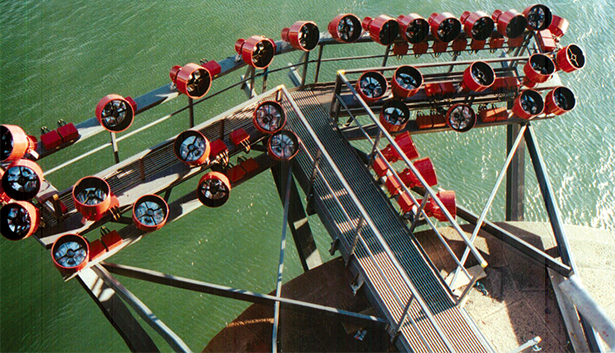Case Study: Forth Bridge Spotlights Celebrations
 The Forth Bridge, Scotland, is being illuminated by over 1000 spotlights positioned along the length of the bridge! The spotlights are mounted on 12 platforms supported out from the piers with an integral walkway to allow access for maintenance. Additionally, over 400 individual lights are mounted on the track side fence. The support structures for these lighting units were designed and fabricated from EXTREN® fiberglass structural shapes by Motherwell Bridge Composites, Glasgow Scotland, and contracted to Electrothermal Limited for Railtrack.
The Forth Bridge, Scotland, is being illuminated by over 1000 spotlights positioned along the length of the bridge! The spotlights are mounted on 12 platforms supported out from the piers with an integral walkway to allow access for maintenance. Additionally, over 400 individual lights are mounted on the track side fence. The support structures for these lighting units were designed and fabricated from EXTREN® fiberglass structural shapes by Motherwell Bridge Composites, Glasgow Scotland, and contracted to Electrothermal Limited for Railtrack.
The lighting positions required by the lighting designer meant that the lights had to be positioned 5m out from the edge of the stone piers which form the bases of the bridge. The high strength of EXTREN® structurals was an essential part of the design to assure that the platform would not deflect in high winds and distort the lighting effect.
The individual light brackets mounted on the trackside fence were hinged to allow the light to be rotated towards the trackside for ease of access and therefore safe working conditions for maintenance. These brackets were light enough to be carried onto the bridge by hand and yet strong enough to support the lights in the gale force winds encountered in the Firth of Forth.
| TECHNICAL DATA |
|---|
| Product: Platforms and Lighting Supports |
| Process: Pultrusion, Fiberglass Fabrication |
| Materials: EXTREN® Series 525 fiberglass structural shapes, isophthalic polyester, fire retardant |
| Fabricated By: Motherwell Bridge Composites - Glasgow, Scotland |
| For: Railtrack |
Fiberglass materials offered many advantages for this application and provided the most cost-effective solution. Corrosion resistance, low maintenance composite materials were ideal for the hostile marine environment since access to certain areas of the bridge is difficult. The lightweight of fiberglass structures was a big benefit in transporting and installing the prefabricated structures. The ease with which composites may be cut and drilled using standard hand tools was also an advantage in meeting the very quick fabrication requirements for this job and in the on-site fabrication (some of which included rope access).